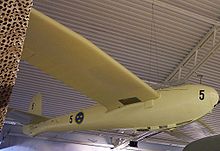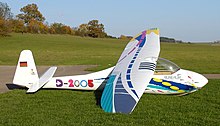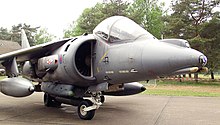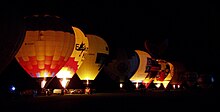Hamm-Lippewiesen Airport
| Hamm-Lippewiesen | |
|---|---|

|
|
| Characteristics | |
| ICAO code | EDLH |
| Coordinates | |
| Height above MSL | 58 m (190 ft ) |
| Transport links | |
| Distance from the city center | 0.74 km north of Hamm |
| Street | Bundesstrasse 63 |
| train | indirectly via Hamm train station , approx. 1.5 km away (footpath & bus connections) |
| Local transport | Bus stop Flugplatz the city bus routes: 2, 4, 9, 11, 12, T10 and the regional bus routes: R14, R37 and 353 operate. |
| Basic data | |
| opening | September 21, 1956 |
| operator | Luftsportclub Hamm e. V. |
| Start-and runway | |
| 06/24 | 900 m × 30 m grass (of which 620 × 20 composite paving) |
The Hamm-Lippewiesen airfield is a special airfield in the Ruhr area on the southern edge of the Münsterland . The airfield is - protected by a dike - north of the Lippe , only a few hundred meters from the Hammer city center.
History of the club and the airfield
The history of the airfield and its operating association began in 1949 with the establishment of a gliding interest group in Hamm. Due to the Second World War and the resulting crew, motor and glider flights were initially only allowed to the Allies in Germany. This restriction was only partially dropped in 1950. The ban on gliding was lifted and the German Aero Club (DAEC) was founded by Wolf Hirth . The community of interests in Hamm then joined this association as a member. In 1951 the community of interests was dissolved and the Hamm Luftsportclub was founded instead. The first chairman was Günter Schmidt. As the first aircraft, the association put a DFS Kranich glider (two-seater) into operation, which was named Bad Hamm . However, in the same year the aircraft was severely damaged when it took off from the Borkenberg airfield.
In 1952 a self-construction was added; the single-seater Baby II was baptized in the name of the hammer pilot Erich Schulte .
In 1953 the large parade ground - today the location of the Maximare - was approved as an airfield for winch starts. However, the approval did not last long. The glider operations soon had to move back to Werl .
The first Hammer Flugtag in 1954 took place on the parade ground; Even then, flight performances were part of the program. The stuntman Arnim Dahl performed climbing exercises in the fresh air during the flight; the glider aerobatic pilot Albert Falderbaum showed his art with his Lo 100 . The Flugtag became a fixture in the city's calendar of events.
The year 1955 brought new opportunities for sports pilots: powered flight was again approved for West Germany. The Hamm Luftsportclub bought an Auster two-seater, but first had to fly in Werl. This state of affairs lasted until September 21, 1956. On this day, today's Hamm-Lippewiesen airfield was opened.
In 1958 an incident occurred: a Tiger-Moth double-decker had to make an emergency landing on the neighboring Heessener Straße and was slightly damaged in the process. The founding chairman Günter Schmidt became a flight instructor at Lufthansa, which was active again in the same year .
In 1959 a new Schleicher K 7 two-seater was purchased. In the course of the flight day, two gas balloons rose for the first time .
In 1960 the oyster had to make an emergency landing east of the airfield due to damage to the wing covering. A new first Piper PA 22 “Colt 108” was added for aircraft fleet training for powered flight operations .
The single-seater glider "Meise" strengthened the air fleet in 1961. At the same time it became necessary to build a new hangar; Since then, there has been space for 14 aircraft in the round hall. In 1961 the first small anniversary of the association took place: It had existed for 10 years and organized a star flight with 18 aircraft to celebrate. The technical upgrade was also carried out this year: a ground radio station went into operation at the airfield.
In 1962, the air fleet continued to grow, with the acquisition of a type K 8 glider .
In 1963, the Hamm Luftsportclub wrote aviation history: It was the first club in North Rhine-Westphalia to receive a license to train pilots after the war.
In 1964 the construction of a control tower and hall 4 followed. With the new acquisition of the motorized two-seater Job 15 , 19 motorized aircraft were now stationed at the airfield . This steady growth was overshadowed by the first fatal flight accident in Hamm in 1966: an airplane of the type Auster did not gain altitude quickly enough after take-off; it brushed against the trees on the ferry road and then fell. The three occupants of the machine die.
Hall 6 (today's glider hangar) was built in 1969. In the same year the city's first elderly fly took place.
In 1970 a large neighbor threatened to dispute the airspace of the small airfield in Hamm. The state of North Rhine-Westphalia decided to create another airport in North Rhine-Westphalia between Drensteinfurt , Albersloh and Sendenhorst . This was planned for 1990. It should be built on an area of 2000 hectares and be equipped with a second expansion stage, an additional runway. By way of comparison: Düsseldorf Airport today has approx. 600 hectares and Cologne / Bonn approx. 1000 hectares. The construction, estimated at 250 million DM , was rejected in 1973 because of the high costs and was never realized.
In 1971 Klaus Rehmann was able to fly in his Focke-Wulf Stieglitz biplane, which was restored in 3000 hours .
In 1973 the glider group bought a two-seater motor glider SF 28 Tandem-Falke . The Hammer participants in the Deutschlandflug , Arthur Wille and Heinz Scharmann, took 6th place out of 158 aircraft that took off.
In 1977 the runway was extended by 200 m to the east.
In 1978 the glider group acquired another aircraft, a single-seater type ASW 19b . It is considered to be the most powerful standard class aircraft of its time.
The workshop hall (Hall 3) was built in 1981.
In 1982 the forecourt of the halls was paved. The club newspaper Hamm-Info also appeared for the first time in 1982 . The open day drew around 20,000 aviation enthusiasts to the Lippewiesen. After the airport was only available to club members in the meantime, it was reopened to non-members in 1983.
At the same time as the first state horticultural show in North Rhine-Westphalia, which took place in Hamm, the airfield was expanded further in 1984. A new gas station and a paved landing area for rescue helicopters were built , which still use this area today when the weather does not allow a direct approach to the city's clinics and hospitals. A new 320 hp winch was purchased to start the glider pilots. A fly-in also took place as a special item on the program for the state horticultural show.
In 1985, the new Hall 2 was built between the workshop hall and the round hall.
The 30th anniversary of the airfield was celebrated in 1986. On this occasion, the Bundeswehr dispatched a Transall , which landed in Hamm and was presented to the public along with other aircraft. The new balloon sport group put their first balloon into operation. He was christened D-Kloster-Alt by Lord Mayor Sabine Zech .
In 1987, Hamm became the landing site for the German flight.
The Flugtag 1988 by a whiz type Hawker Siddeley Harrier and a Supermarine Spitfire visited. The Lippe rally with 19 hot air balloons took place at the same time . Another glider strengthened the air fleet, a motor glider of the type Scheibe SF 25 . In addition, a separate workshop for the gliders was completed as an extension to the glider hangar.
At the suggestion of Luftsportclub one was Boeing 737 of Lufthansa in the name of the city Hamm baptized.
The Lippe rally was continued in 1990 with 29 hot air balloons. The airfield festival took place for the first time this year with the participation of aircraft from the GDR . The event was attended by 35,000 visitors. Another hall (hall 7) was built to the east of the glider hangar.
Whitsun 1991 the Montgolfiade started in Hamm with 60 hot air balloons. In July, the distance gliding competition "Hammer Week" took place for the first time.
The great aviator Andrea Brockmann was runner-up in the club class at the German ladies' gliding championships in 1992. The Montgolfiade took place again in Hamm and attracted 64 balloon teams to the Lippe meadows. The second "hammer week" was won by a large margin by the Dutch professional pilot Hans Biesters.
The aviation engineering company Hamm received approval from the Federal Aviation Office in Braunschweig in 1993 . For air fleet glider was to replace the Schleicher ASK 13 a Schleicher ASK 21 acquired. This also meant the end of the conversion to plastic aircraft. The Fliegerklause was also renovated and reopened in the same year. The kite festival was combined with the Lippe rally for hot air balloons; more than 10,000 spectators came.
In 1994 Günter Schmidt, the founding chairman of the air sports club, received the club's golden badge of honor. This now had 410 members and hosted the 9th German Dragon Flying Championship on the airfield.
Finally, on April 22, 1995, a new control tower was inaugurated (in the presence of the NRW Minister of Transport). In addition, initial talks began about fortifying the runway. In autumn the European championships in stunt kite flying took place on the airfield for the first time.
In 1996 the airfield festival was held on September 21st. on this day the 40th anniversary of the airfield could be celebrated. An extension to the glider hangar, Hall 6a, expanded the space at the airfield.
The new runway was finally inaugurated on April 27, 1997. It consisted of water-permeable special stones. In the same year, the club and the airport launched their first website .
In 1998 the 13th German Dragon Championship took place on the airfield. In 1999 LSC Hamm won the international balloon meeting in Öscény in Hungary for the first time. The winning balloon was named D - Werne .
In 2000, the Lord Mayor of Hamm named the association's fifth balloon with the name of the City of Hamm . The club's balloonists then managed to defend their title at the meeting in Öscény.
On May 5, 2001, the balloon sport group celebrated its fifteenth anniversary. In the summer of the year a new filling station for AVGAS and MOGAS was built .
The fiftieth anniversary of the airfield was celebrated on September 21, 2006.
On December 2, 2010, the club's entire fleet of balloons and four aircraft were destroyed by fire. The balloon hall and the adjacent aircraft hangar were so badly damaged by the fire that both had to be demolished. Among the burned balloons was the "old" Pils glass from the Warsteiner brewery , which was the trademark of the balloon sport group . The cause of the fire could not be properly clarified.
The newly built halls were put into operation at the beginning of 2012.
Facilities
In addition to a tower with a ground radio station and some hangars for aircraft, there is also an aeronautical company in Hamm. There is also a café-restaurant: Die Fliegerklause .
LSC Hamm club flying school
The LSC Hamm flight school is one of the largest club flight schools in Germany. It has 20 flight instructors. Training is provided in the areas of powered flight , gliding , balloon sport and ultralight with the club's own aircraft. It is the oldest licensed flight school in NRW.
Air Service Lippewiesen (ASL)
The air service company in Hamm, Air Service Lippewiesen , was founded in 1965. The facility has changed significantly in recent years. In the beginning she was only responsible for the maintenance of the club planes of the air sports club Hamm, today she is a modern service company that has opened up economically to the outside world.
In mid-October 2008, Air Service Lippewiesen GmbH had to file for bankruptcy. The then managing director of the air sports club and the GmbH, Rudolf Rottmann, resigned at the same time for internal and personal reasons . In the meantime, Skytec Airservice GmbH has taken over the operation.
Airports in the region
Hamm Airfield is located in the triangle between Münster-Osnabrück , Dortmund and Paderborn-Lippstadt airports .
The helipad is paved as is its access road and is regularly used for patient transport when the neighboring clinics can no longer be approached directly due to bad weather.
Admission and operating times
The aerodrome is approved for powered aircraft up to a maximum take-off weight of 2000 kg, gliders , microlights and helicopters up to 3500 kg. This does not apply to rescue helicopters, which may have a maximum take-off weight of up to 6000 kg.
In airworthy weather, the flight control is usually on weekdays from 10 a.m. to 8 p.m. (summer time), from 1 p.m. to sunset (winter time) and on weekends and holidays from 9 a.m. (summer time) or 10 a.m. (winter time) to 8 p.m. local time or Sunset busy.
Events
The annual airfield festival of the Luftsportclub Hamm e. V. is very popular and is therefore regularly visited by up to 30,000 people. The air show has become a tradition and has been taking place since 1954. The then Flugtag called event was so even before the opening of the airport rather than on the large parade ground in the hammer East.
Web links
Individual evidence
- ↑ Westfälischer Anzeiger of October 21, 2008, title page / local.








